What Clothes To Wear In Thailand? [Thailand Packing Tips For Males & Females]
Luke Iles – Uploaded 28.05.2024

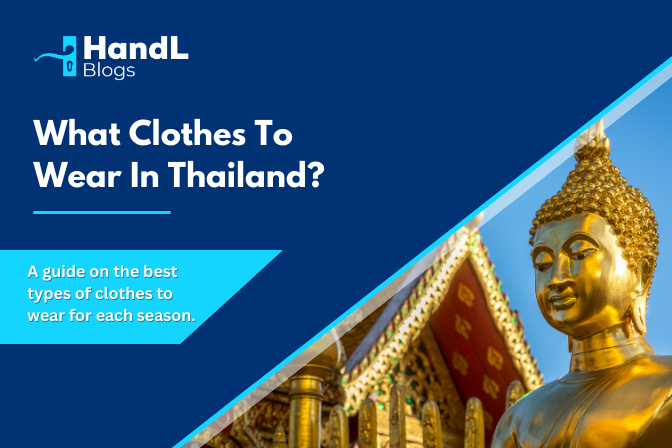
What Should You Wear In Thailand?
Once you have planned your holiday, booked your flights, secured your visa and sorted your travel budget, the only thing left is to pack your bags! However, when it comes to travelling to Thailand, what clothes do you need to pack?
Thailand has a tropical climate which varies throughout the months with the dry season ranging from around November to June and the wet season occurring from July to October in the majority of places in Thailand.
Therefore it is important to know what to pack and what clothes to wear in Thailand on your trip so you can be prepared for everything. It is also important to understand the Thai dress code and depending on where you are visiting and staying in Thailand can affect what clothes you need to wear.
As someone who has travelled across Thailand in both rainy and dry seasons, it is fair to say I have a decent understanding of what different clothes you need to wear. With that being said I have been caught out not wearing the appropriate clothing which has led to some days where my trip didn’t go as well as I had planned.
For this reason, I have created this blog so that you can get a great idea of the best clothes to wear for your next Thailand trip!
Clothing Checklist for Thailand
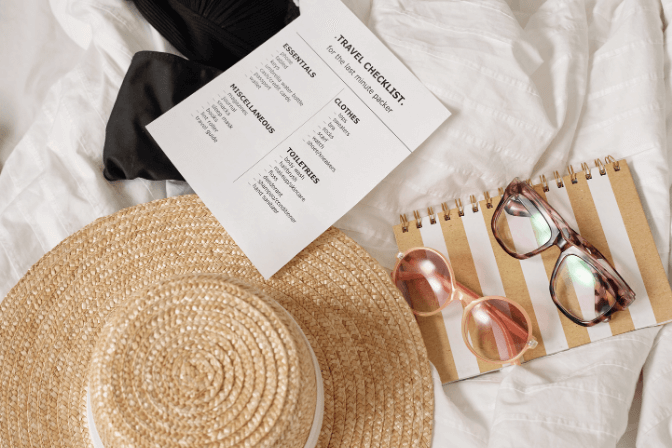
Whether you are a male or female travelling to Thailand it is fair to say that we all bring and pack different things. My top tip that you need to follow is if you are planning to travel around to different places in Thailand, take a backpack and travel light!
You do not want to be that person having to wade through the sea with a heavy suitcase and dump it on a boat ferry with no space. For this reason, I would only bring a suitcase if you are planning to stay in one place for the entire trip such as if you were staying in Bangkok.
Although everyone has their own preferences and has planned their own trip, I have created a rough checklist of what you should consider taking if you were looking to backpack around Thailand for a month in the dry season (November – June).
You should aim to pack light and simply be prepared to head to a laundrette on the second week to get everything washed.
In Thailand depending on where you stay you can pay around £1.00 to get 1 kg of dirty laundry washed and dried within a day by someone so don’t worry about re-wearing dirty articles of clothes!
Clothing Checklist for Men
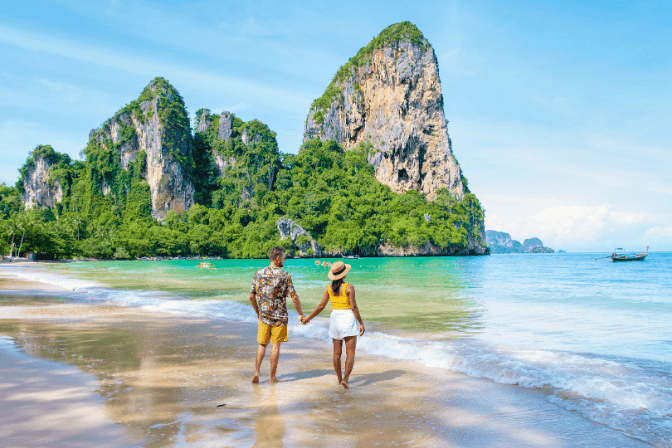
Tops:
- 7-8 lightweight t-shirts or tank tops (quick-drying, moisture-wicking)
- 1-2 long-sleeve shirts (for sun protection and cooler evenings)
- 1 lightweight hoodie or sweater (for cooler nights in the north)
- 2-3 button-up shirts (for temples and nicer outings)
Bottoms:
- 4-5 pairs of lightweight, quick-drying shorts
- 1 lightweight pair of trousers (to be worn in temples and high end bars in Bangkok)
- 2 pairs of swim trunks
Undergarments:
- 7-10 pairs of underwear
- 6-7 pairs of socks (include a pair of thicker socks for hiking)
Footwear:
- 1 pair of comfortable walking shoes or trainers
- 1 pair of flip-flops or sandals (for the beach and casual wear)
- 1 pair of lightweight hiking shoes or trail runners (optional, if you plan to hike)
Miscellaneous:
- Backpack (35-50L, with a rain cover)
- Daypack (10-20L, for day trips and excursions)
- Lightweight, quick-drying towel
- Travel-sized toiletries (shampoo, conditioner, body wash, toothbrush, toothpaste, etc.)
- Sunscreen (reef-safe for beach destinations)
- Insect repellent (with DEET or natural alternatives)
- Reusable water bottle (with a built-in filter is a bonus)
- Sunglasses
- Hat or cap (for sun protection)
- Rain poncho or lightweight rain jacket (even during the dry season, occasional rain is possible)
Clothing Checklist for Women

Tops:
- 5-6 lightweight t-shirts or tank tops (quick-drying, moisture-wicking)
- 2-3 lightweight blouses or tunics (for versatility and modesty in temples)
- 1-2 long-sleeve shirts (for sun protection and cooler evenings)
- 1 lightweight hoodie or sweater (for cooler nights in the north)
- 1 maxi dress
Bottoms:
- 5-6 pairs of lightweight, quick-drying shorts
- 1-2 pairs of lightweight pants (zip-off hiking pants or comfortable leggings)
- 1-2 skirts or dresses (lightweight, easy to pack, and great for hot weather)
- 2 pairs of swimwear (bikini, bathing suits or one-piece)
Undergarments:
- 7-10 pairs of moisture-wicking underwear
- 6-7 pairs of socks (include a pair of thicker socks for hiking)
- 5-7 bras (sports bras or regular bras, depending on your preference)
Footwear:
- 1 pair of comfortable walking shoes or sneakers
- 1 pair of flip-flops or sandals (for the beach and casual wear)
- 1 pair of lightweight hiking shoes or trail runners (optional, if you plan to hike)
Miscellaneous:
- Backpack (35-50L, with a rain cover)
- Daypack (10-20L, for day trips and excursions)
- Lightweight, quick-drying towel
- Travel-sized toiletries (shampoo, conditioner, body wash, toothbrush, toothpaste, etc.)
- Feminine hygiene products (tampons, pads, menstrual cup)
- Sunscreen (reef-safe for beach destinations)
- Insect repellent (with DEET or natural alternatives)
- Reusable water bottle (with a built-in filter is a bonus)
- Sunglasses
- Hat or cap (for sun protection)
- Rain poncho or lightweight rain jacket (even during the dry season, occasional rain is possible)
Clothing Tips for the Dry Season
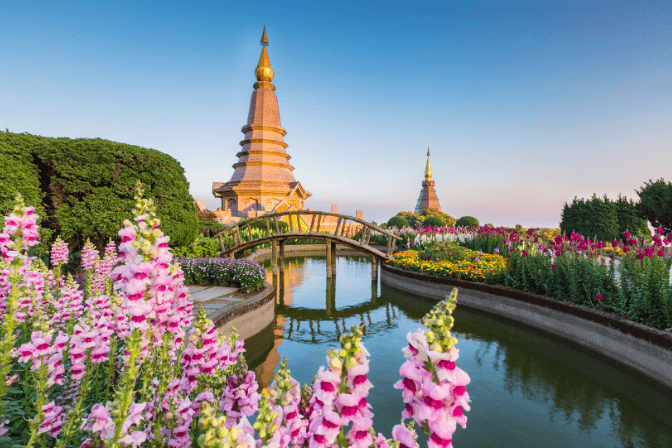
When travelling to Thailand during the dry season, particularly from March to June, prepare for intense heat and high humidity both day and night. Pack light, breathable clothing to stay comfortable in the hot and humid climate.
Opt for moisture-wicking fabrics like light cotton, or linen for your tops and bottoms to keep cool and dry. Think short-sleeved cotton t-shirts, comfortable skirts, and shorts. Women should consider packing a long maxi dress and a thin shawl for cooler evenings, while men should bring a pair of linen trousers and a long-sleeved linen shirt, to fend off mosquitoes.
While Thailand offers affordable clothing at local markets, it’s wise to bring certain items from home. Good-quality moisture-wicking underwear and comfortable, supportive walking shoes can be harder to find and often more expensive locally.
I recommend packing a lightweight scarf or sarong, which serves multiple purposes from covering shoulders in temples to acting as a beach cover-up or impromptu picnic blanket. Additionally, a lightweight rain jacket is useful for the occasional downpour or cooler evenings in the northern regions like Chiang Mai and Pai.
Clothing Tips for the Rainy Season
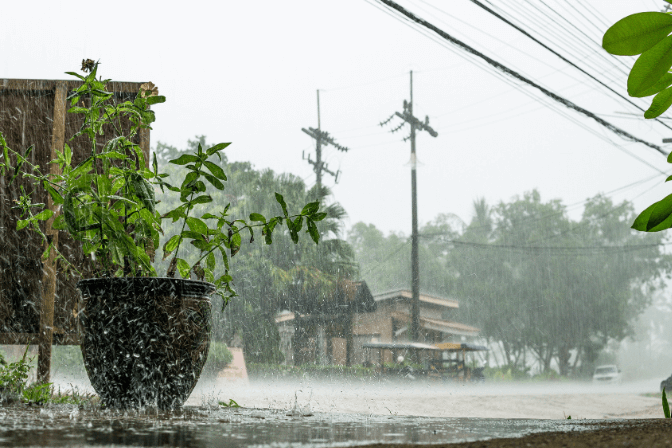
When travelling to Thailand during the rainy season, from June to October, it’s important to prepare for frequent downpours and high humidity. Pack light, breathable clothing that can dry quickly, as well as waterproof items to stay comfortable and dry.
Think of moisture-wicking fabrics like cotton or synthetic blends for your tops and bottoms. Short-sleeved t-shirts, comfortable skirts, and shorts are still essential but also consider quick-drying options. Women should pack a long maxi skirt and a thin shawl for cooler evenings, while men should include a pair of linen trousers and a long-sleeved shirt to fend off mosquitoes.
While you’re bound to experience some drizzle, the rain often provides a refreshing break from the persistent humidity and it’s an excellent time to take advantage of lower prices on hotels and flights. Thailand’s monsoon season generally spans from July to October, but rainfall can vary by region. For instance, the southern province of Ranong, experiences heavy rain from April to November, with showers lasting from minutes to hours, so packing a reliable raincoat is crucial. Embrace the rain and enjoy the perks of fewer crowds and budget-friendly travel.
Additionally, consider packing a small, quick-drying towel and extra ziplock bags to keep your electronics and important documents dry. These items will ensure you stay comfortable and prepared for the changing weather conditions during your trip.
What to Pack for Beaches and Islands in Thailand?
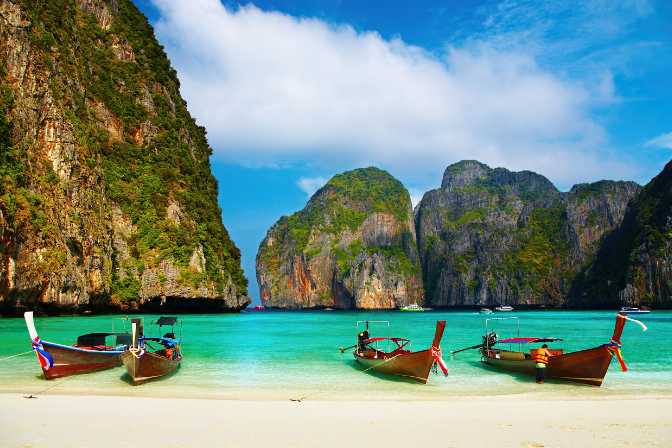
If you are heading down South to some of the best Thailand islands such as Koh Samui, Koh Phi Phi or Phuket, there are some things you want to make sure you take. Start with the basics: sandals, sunhats, sunglasses, and, of course, a high-SPF sunscreen to shield your skin from the intense tropical rays.
Opt for lightweight fabrics like cotton or linen, offering breathability and quick-drying properties ideal for the humid climate and don’t shy away from bright colours and bold patterns to embrace the vibrant tropical atmosphere.
Complete your look with a wide-brimmed hat or cap to provide extra shade and protection, ensuring you stay cool and comfortable throughout the day. For added sun protection during peak hours or cooler evenings by the shore, consider bringing along a lightweight, long-sleeved cover-up or kaftan.
To navigate rocky beaches or engage in water sports with ease, invest in a good-quality pair of water-resistant sandals or water shoes, offering both comfort and traction on slippery surfaces.
What to Wear in the City?
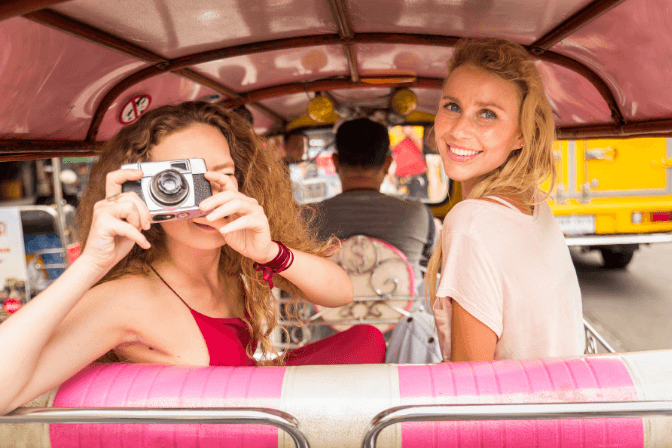
If you are planning to stay in big cities such as Bangkok or Chiang Mai there are some different types of clothing you need to consider packing. Opt for lightweight, breathable fabrics like cotton or linen to combat the tropical heat while maintaining a fashionable look.
For men, a pair of tailored shorts or lightweight pants paired with a casual button-up shirt or polo is both comfortable and appropriate for city exploration. Women can opt for flowy skirts or comfortable pants paired with breezy tops or blouses, keeping in mind the need for modesty in certain cultural settings.
Consider bringing a light jacket or scarf for cooler evenings or air-conditioned spaces, and don’t forget comfortable walking shoes to tackle the bustling streets and vibrant markets. Accessorize with a stylish hat or sunglasses for added flair while protecting yourself from the sun.
Lastly, be respectful of local customs by avoiding overly revealing clothing and opting for conservative attire when visiting temples or religious sites.
What to Wear to The Grand Palace and Temples in Thailand?
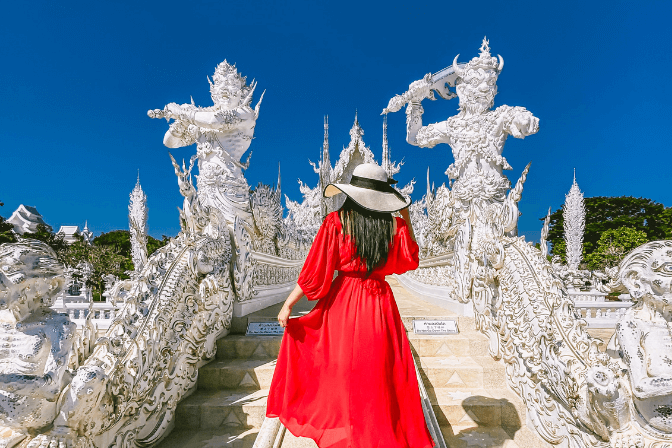
Before you go inside, it’s worth knowing that crop tops, shorts, and t-shirts are a no-go. Since these treasured temples hold religious importance, you’re advised to cover your shoulders with a shawl, wear a long-sleeve top, and appropriate trousers as a sign of respect.
Slip-on shoes are also a must, as you’ll need to remove them before you enter the temple. Opt for modest attire that covers your shoulders, arms, and legs to adhere to traditional Thai customs and show respect for the sacred spaces you’re entering.
For both men and women, lightweight, breathable fabrics like cotton or linen are ideal for staying cool in the tropical climate while maintaining a conservative appearance. Women should consider wearing loose-fitting pants or skirts that fall below the knee, paired with a blouse or top that covers the shoulders and chest.
Avoid tight or revealing clothing, as well as clothing with offensive language or imagery. Men should opt for long pants and collared polo shirts, avoiding sleeveless tops or shorts. Remember to remove your shoes before entering temple buildings, and consider bringing along a scarf or shawl to cover your shoulders if needed. Therefore, I would wear shoes which are easy to slip on and off but also comfortable for walking around cities such as Bangkok in.
With that being said outside of the Grand Palace and most temples, you will find vendors selling long sleeves, pants and formal attire so that you can get into the attractions. Therefore, if you don’t mind paying money, you can simply purchase the formal attire before entering. That being said it is better to be prepared.
Conclusion
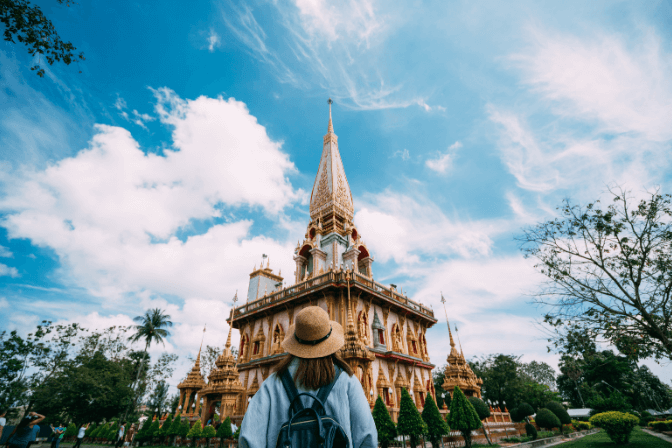
In conclusion, when packing for a trip to Thailand, it’s important to prioritize comfort, practicality, and cultural sensitivity in your clothing choices. Opt for lightweight, breathable fabrics to combat the tropical heat, and choose modest attire, particularly when visiting religious sites such as temples and the Grand Palace. Remember to cover your shoulders, arms, and legs in these sacred spaces, and always remove your shoes before entering temple buildings. By dressing respectfully and thoughtfully, you’ll not only stay comfortable in Thailand’s diverse climates but also show respect for the local customs and traditions, enhancing your overall travel experience.
Read Travel Blogs & More
Disclosure: Some links in this article may be affiliate links, which can provide compensation to HandL Blogs at no cost to you if you decide to purchase through these links. These are products we have personally used and stand behind. This site is not intended to provide financial advice and is for entertainment only. You can read our affiliate disclosure in our privacy policy.

Luke Iles
Luke is a leading travel writer within the travel niche and is also a co-founder of HandL Blogs one of the UK’s leading travel blogging websites. Luke has a love of all things travel.
Initially becoming friends with his other co-founder, Harry, at the age of four years old, they let their love for travel evolve, making it their mission to visit every country in the world!
Today they want to share their passion and experiences of travelling across the globe with written blogs on topics that are most important to them. From travel, cooking, fitness and tech blogs!
Whether that be trying new food in a new country and sharing it in a cooking blog; visiting a new gym in a certain city and reviewing it in a fitness blog or learning about the newest tech within the travel industry.
Disclosure: Some links in this article may be affiliate links, which can provide compensation to HandL Blogs at no cost to you if you decide to purchase through these links. These are products we have personally used and stand behind. This site is not intended to provide financial advice and is for entertainment only. You can read our affiliate disclosure in our privacy policy.
